2022
January 13 - February 19: Angie Quick: the moonlight made me do it & six feet | between us
the moonlight made me do it
Angie Quick
January 13 - February 19, 2022
Curated by Helen Gregory

Angie Quick, tell it to me like i have been bad all my life 2021. Oil on canvas. Courtesy of the artist.
Initially inspired by the gift of a deck of Moon Cards – a purported means of harnessing the power of the moon to gain clarity and connect to your intuition and emotional health through self-love and ritual – London, Ontario-based artist Angie Quick discovered that the cards’ intended purpose instead became the catalyst for an investigation into human culpability. When the influence of the moon takes effect, are we fully responsible for our deeds and desires?
Throughout these paintings, Quick combines art historical tropes such as landscape painting, images of hunting dogs and dead rabbits, and frolicking cherubim to create a lexicon of images that are apocalyptic but tempered by an infusion of hope and an otherworldly sweetness. Familiar images are rendered uncanny through the insertion of peculiar elements: babies are adorned with strange hats and ghost costumes; rabbits gather around what appears to be a mound of earth but on second glance is a pair of upturned female buttocks; a deceased cat is transported to heaven by a host of faceless cherubim; and seemingly traditional landscapes are interrupted by gestural marks of pure abstraction. Collectively, they invoke an aura of cosmic strangeness, demanding that we rethink the natural world and open ourselves up to the possibility of new historical and futuristic imaginings.
Angie Quick (she/her) is an artist working in the London Township Treaty territory.
six feet | between us
Derek Boswell
January 13 - February 19, 2022
Curated by Kevin Heslop
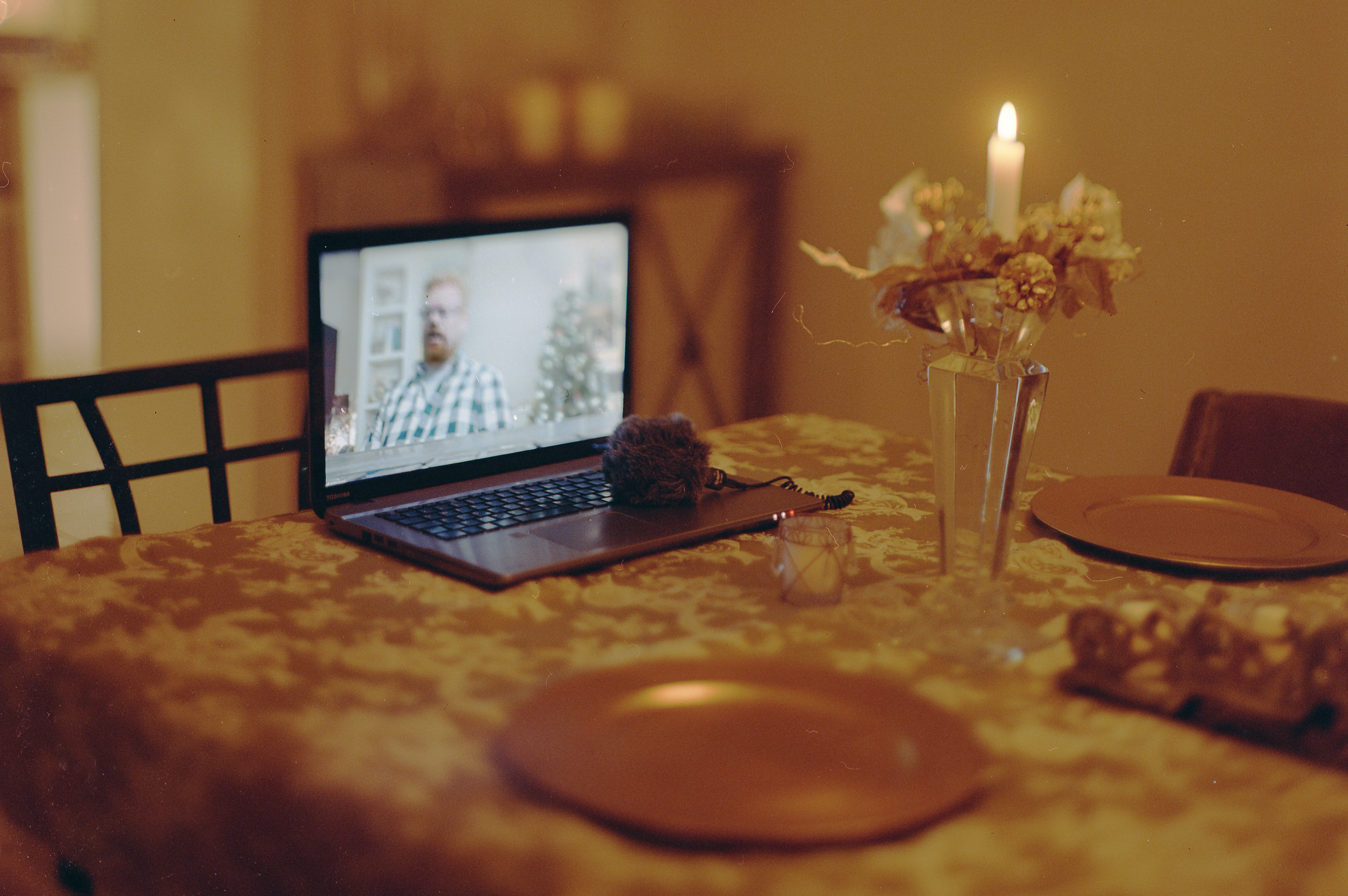
Derek Boswell, this too (detail) 2020. Chromogenic print from Kodak Portra negative. Courtesy of the artist.
 This syntactic torsion proposes to destroy and enphoenix the colonial, heteronormative repository of the English language while the embedded title of the exhibition itself, a meditation on both the enforced distance among participants in a viral society and the distance between our bootsoles and the dead, proposes several questions: if the best of Western philosophy and the English language has brought us to a state of environmental catastrophe, of what use are either? From each, what inevitabilities ensue? Will that which precipitated this pandemic precipitate another? “the virus is the thought we are individuals the thought we are individuals is / the virus is the thought we are individuals the thought we are individual is / the virus is make the impermeable barrier of the self great a / -gain wealth forgetting all but self i …” If we proceed to indulge in the myth of individuality, which is to say a unit of consciousness separable from its environment, and if we continue to promote the myopic supremacy of the individual over that environment, Heslop and Boswell suggest, catastrophe will ensue: favour dialogue, meditation, resourcefulness; go light.
This syntactic torsion proposes to destroy and enphoenix the colonial, heteronormative repository of the English language while the embedded title of the exhibition itself, a meditation on both the enforced distance among participants in a viral society and the distance between our bootsoles and the dead, proposes several questions: if the best of Western philosophy and the English language has brought us to a state of environmental catastrophe, of what use are either? From each, what inevitabilities ensue? Will that which precipitated this pandemic precipitate another? “the virus is the thought we are individuals the thought we are individuals is / the virus is the thought we are individuals the thought we are individual is / the virus is make the impermeable barrier of the self great a / -gain wealth forgetting all but self i …” If we proceed to indulge in the myth of individuality, which is to say a unit of consciousness separable from its environment, and if we continue to promote the myopic supremacy of the individual over that environment, Heslop and Boswell suggest, catastrophe will ensue: favour dialogue, meditation, resourcefulness; go light.Derek Boswell is a Canadian artist, born in 1995, in London, Ontario. Derek’s work primarily centres around the medium of photography and draws from his wide-ranging explorations of topics such as the Anthropocene, esoteric photographic techniques, and the role of photography’s truthful traditions in a post-truth world. Derek is a graduate of Western University's Visual Arts program and is currently a teacher-candidate at Althouse College.
Kevin Andrew Heslop is a polydisciplinary doofus from where Deshkan Ziibi antlers unceded to treaty through London Township Purchase [sic] territory whose debut poetry collection, the correct fury of your why is a mountain, appeared with Gordon Hill Press in 2021 and whose work as a filmmaker, journalist, playwright, and curator is forthcoming with Museum London (2022), The /temz/ Review (2022), TAP: Centre for Creativity (2022), and Westland Gallery (2023) respectively.
March 3 - April 16: Thelma Rosner: Where Can I Go Now? & Unconventional
Where Can I Go Now?
Thelma Rosner
March 3 - April 16, 2022
Curated by Helen Gregory
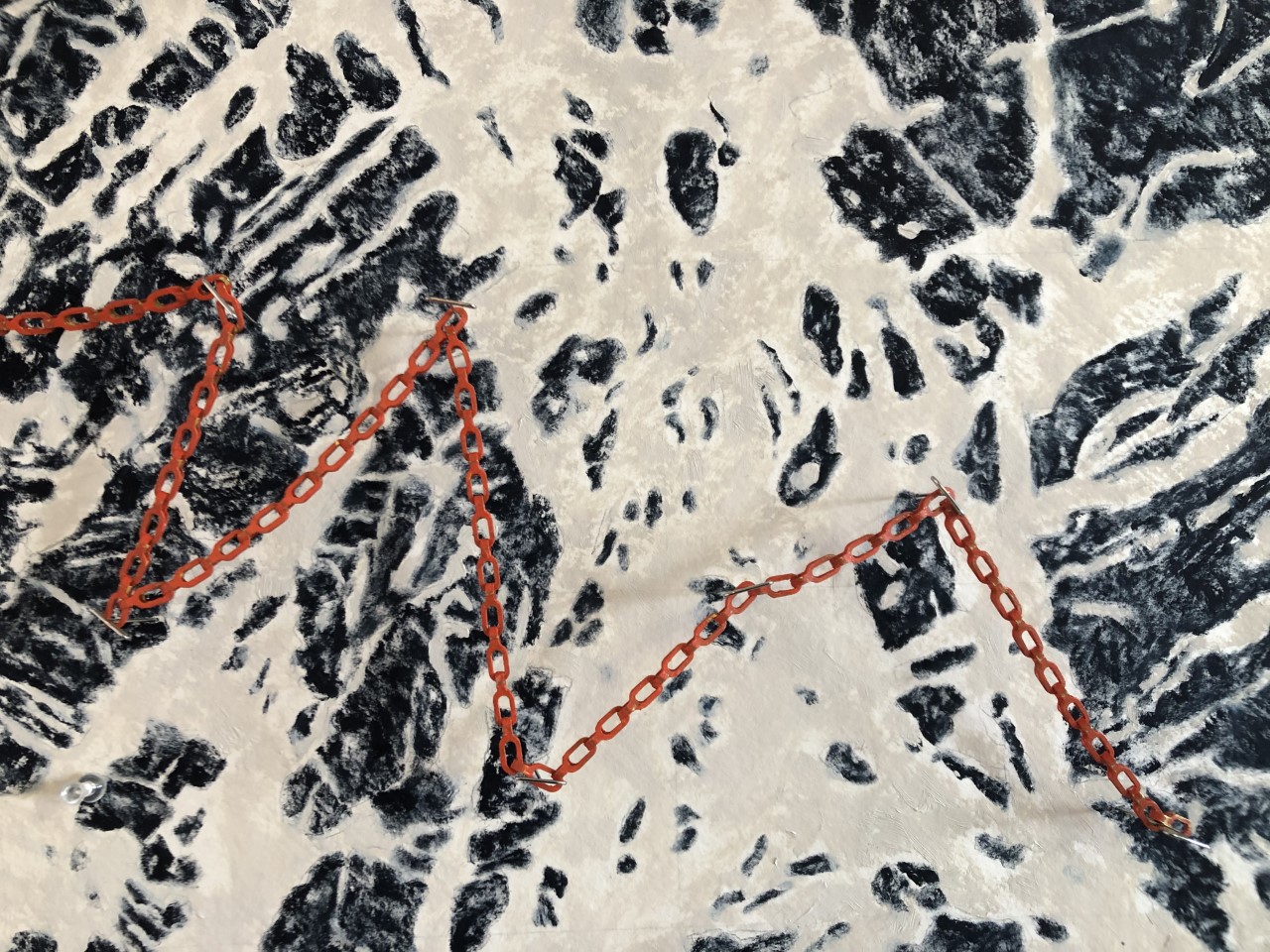 Thelma Rosner, Five Years' Passage (detail). Mixed media installation. Courtesy of the artist.
Thelma Rosner, Five Years' Passage (detail). Mixed media installation. Courtesy of the artist.
Throughout her practice, London, Ontario-based artist Thelma Rosner has consistently employed narrative as a means to reflect on the Jewish diaspora. The catalyst for this exhibition was an autobiographical work written by Elisabeth M. Raab, a survivor of Auschwitz concentration camp during World War II. Beginning in 1944 with the forced transport from her home in Hungary to Auschwitz, Raab ultimately went on to make seventeen separate journeys over the ensuing five years. Permanently displaced following her liberation by Allied forces in 1945, Raab no longer had a home to which she could return and was left to travel throughout Europe without any clear connection to place.
Rosner considers Raab’s postwar experience within a recent historical trajectory, making connections between post-war displacement and the plight of contemporary refugees. In preparation for this project, Rosner consulted immigrants to Canada, including members of her own family, personal acquaintances, and new Canadians met through the London Cross Cultural Learner Centre. After interviewing each person, Rosner requested permission to photograph a significant object brought with them on their journey to Canada. Each object is linked to a past life and carries profound emotional resonance. Inextricably connected to memory and place, these objects are souvenirs in the truest sense of the word. In the absence of their original contexts, they form tangible connections to a past life, evoking memories, emotions, stories. As Susan Stewart reminds us, “this capacity of objects to serve as traces of authentic experience is, in fact, exemplified by the souvenir. The souvenir distinguishes experiences. We do not need and desire souvenirs of events that are repeatable. Rather we need and desire souvenirs of events that are reportable, events whose materiality has escaped us, events that thereby exist only through the invention of narrative.” Displaced from their points of origin, each of the objects that Rosner depicts evokes a narrative that keeps memories from fading into impermanence.
Thelma Rosner is a London, Ontario-based artist whose practice includes painting, printmaking, and installation. In the 1970s, Rosner was a part-time student in the Fine Art department at the University of Western Ontario under the mentorship of Paterson Ewen. Although some of her professors warned her against the danger of “illustrating stories”, Ewen didn’t impose such restrictions. Over the years, Rosner has become increasingly interested in the power of narrative and has often turned to books as stimuli for her artistic practice. The subjects of her work include food and culture, and the intersections of Jewish and Muslim history. More recently, her work has been inspired by the personal narratives of immigrants and refugees to Canada. Rosner suggests that this interest is perhaps a reflection of the stories told to her by her own immigrant parents and family.
Rosner has exhibited widely across Ontario, at such galleries as Museum London, McIntosh Gallery (London, ON), Justina M. Barnicke Gallery (Toronto), Burlington Art Centre, Art Gallery of Peterborough, Robert McLaughlin Gallery (Oshawa), and McMaster University Art Gallery (Hamilton). Her work is held in numerous private and public collections including the Canada Council Art Bank, Museum London, London Board of Education, McIntosh Gallery, Western University, John Labatt Ltd., and London Life Insurance. She is the recipient of grants from the Ontario Arts Council, Banff Centre for the Arts, and Canada Council for the Arts.
Unconventional
20th Century International Prints from the McIntosh Gallery Collection
March 3 - April 16, 2022
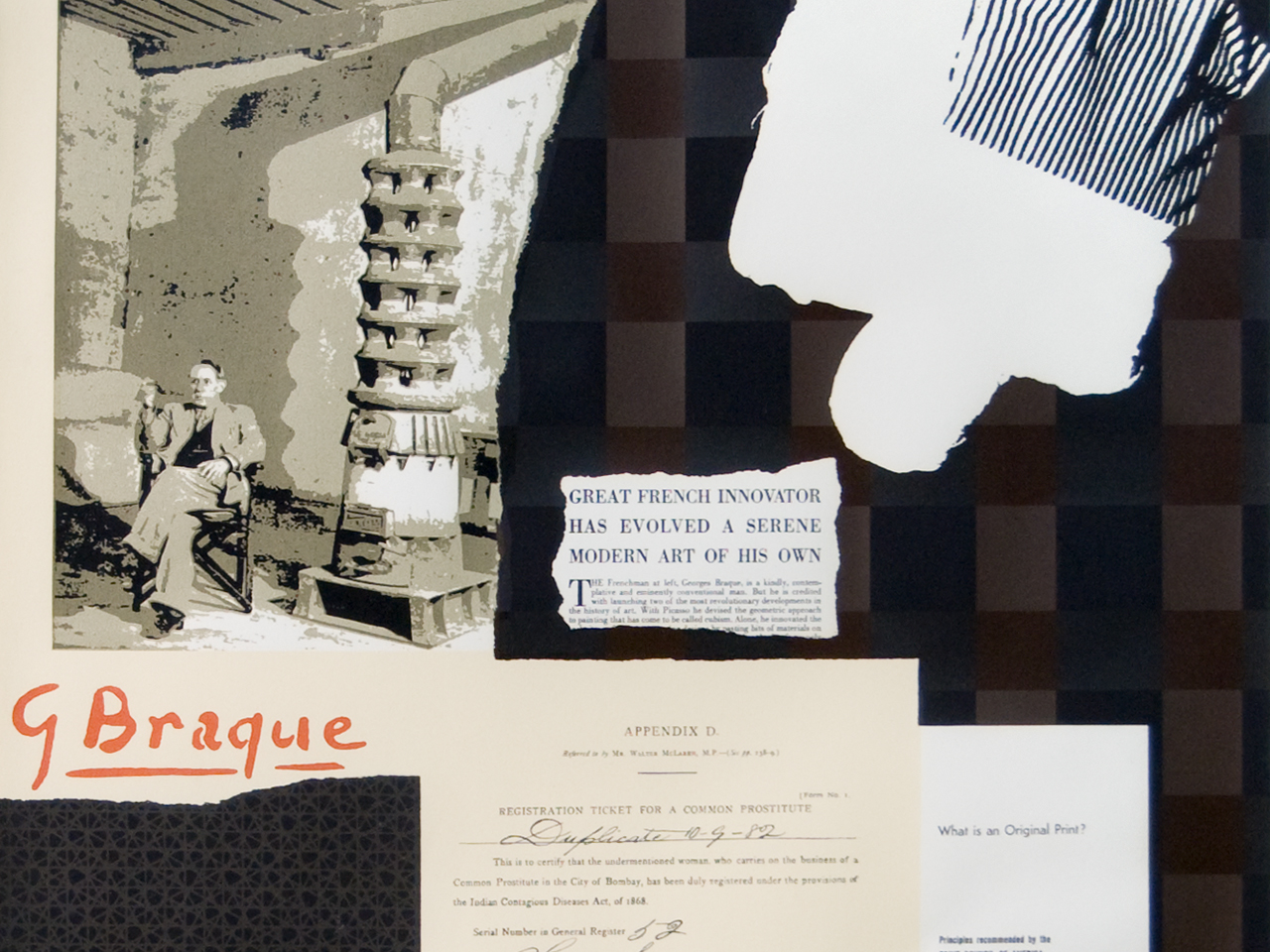 Ronald Kitaj (American, 1932-2007), The Defects of Its Qualities (detail) 1967. 11 colour screenprint, photo screenprint collage. McIntosh Gallery Collection, Western University. Gift of David and Marilyn Conklin, 2010; © The Estate of R. B. Kitaj, courtesy Marlborough Gallery, New York.
Ronald Kitaj (American, 1932-2007), The Defects of Its Qualities (detail) 1967. 11 colour screenprint, photo screenprint collage. McIntosh Gallery Collection, Western University. Gift of David and Marilyn Conklin, 2010; © The Estate of R. B. Kitaj, courtesy Marlborough Gallery, New York.
The McIntosh Gallery Collection of over 4,200 objects is widely recognized for its unique holdings as a rich resource for the promotion and appreciation of local and nationally significant artists. In addition, works by distinguished international artists help position Canadian art practices within a global context. This diversity is made possible by all of our generous donors whose invaluable contributions have significantly enhanced the Collection’s development.
Among the numerous artworks given by longtime supporters David and Marilyn Conklin is a selection of outstanding international prints by Jim Dine, Richard Hamilton, Ronald Kitaj, Robert Motherwell, and Antoni Tàpies. During careers launched in the social and economic upheavals of the mid-twentieth century, their work challenged categorization with their individual unconventional approaches to artmaking. They elevated commonplace objects into iconic symbols, appropriated images from popular culture, and embraced autobiographical and figurative elements in direct opposition to minimalism and conceptualism.
April 28 - June 18: Insect as Idea
Insect as Idea
Carl Beam, Christi Belcourt, Catherine Chalmers, Andrea Cooper, Aganetha and Richard Dyck, Jude Griebel, The Institute of Queer Ecology, Jennifer Murphy and Amy Youngs
Featuring insect specimens from the Zoological Collections, Department of Biology, Western University
April 28 - June 18, 2022
Curated by Dr. Helen Gregory and Dr. Nina Zitani
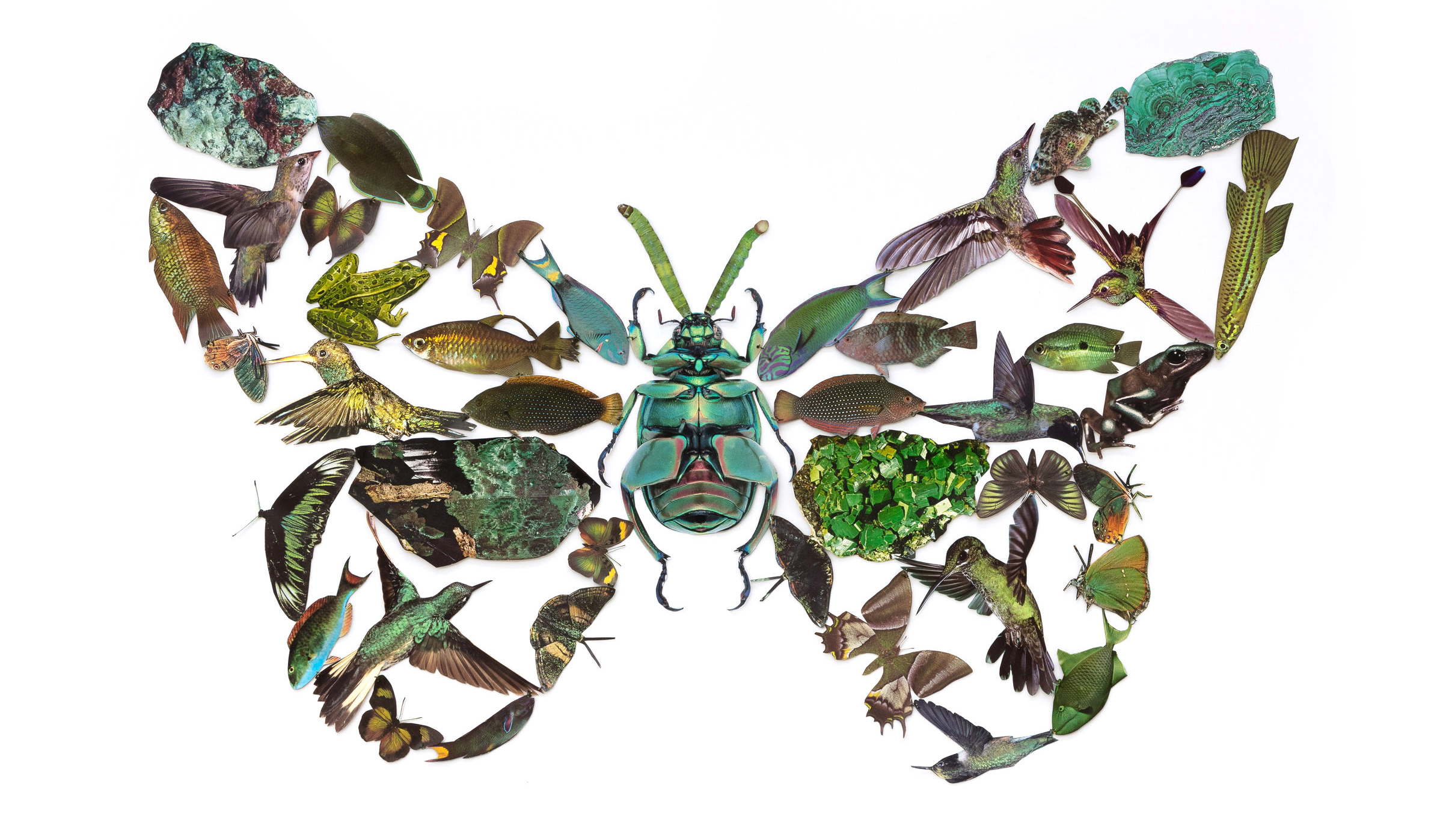
Jennifer Murphy, Scarab Butterfly 2020. Collage of cut images from second-hand books sewn together with thread. Courtesy of the artist and Clint Roenisch Gallery.
From the imperceptible flutter of a butterfly wing to the electric buzzsaw whine of summer cicadas, the thrum of insects forms a subtle soundtrack to our quotidian existence. Insects have captured human imagination for centuries. The ancient Greeks equated butterflies with the soul to such an extent that they used the same word – psyche – to refer to both. Aristotle devoted considerable attention to the study of natural history and was especially fascinated by the complete metamorphosis of insects. He regarded the transformation as a means by which an imperfect animal could attain the condition of perfection, which he associated with the notion of telos, meaning full potential or inherent purpose.
Insect as Idea examines insects within a multispecies framework, considering the role that they play throughout ecological systems. How have we learned from insects in the past and what can they tell us about the future? If we read insects as bellwethers or even, more poetically, as ideas made manifest, what does their disappearance say about human-earth relationships? This exhibition puts the work of artists Carl Beam, Christi Belcourt, Catherine Chalmers, Andrea Cooper, Richard and Aganetha Dyck, Jude Griebel, The Institute of Queer Ecology, Jennifer Murphy and Amy Youngs in conversation with the exquisitely beautiful historical collection of Riker Mounts housed in the Zoological Collections at Western University. Many of the specimens housed in the Zoological Collections were collected in the early twentieth century by former professors and scientists as part of their research projects. Other specimens were collected by local hobby naturalists and later donated to Western, including a collection of Riker mounts on display here. Such historical collections have roots in the history of colonialism and are characterized by the impulse to exhibit dominance over nature through the collection and display of rare species. Today, however, they collectively serve a new role in documenting past species occurrences allowing scientists to track changes in biodiversity locally and globally. They are also an important educational tool, allowing students to see real specimens of insect biodiversity from North America to the Amazon Rainforest, Africa, India, Southeast Asia and other localities around the globe.
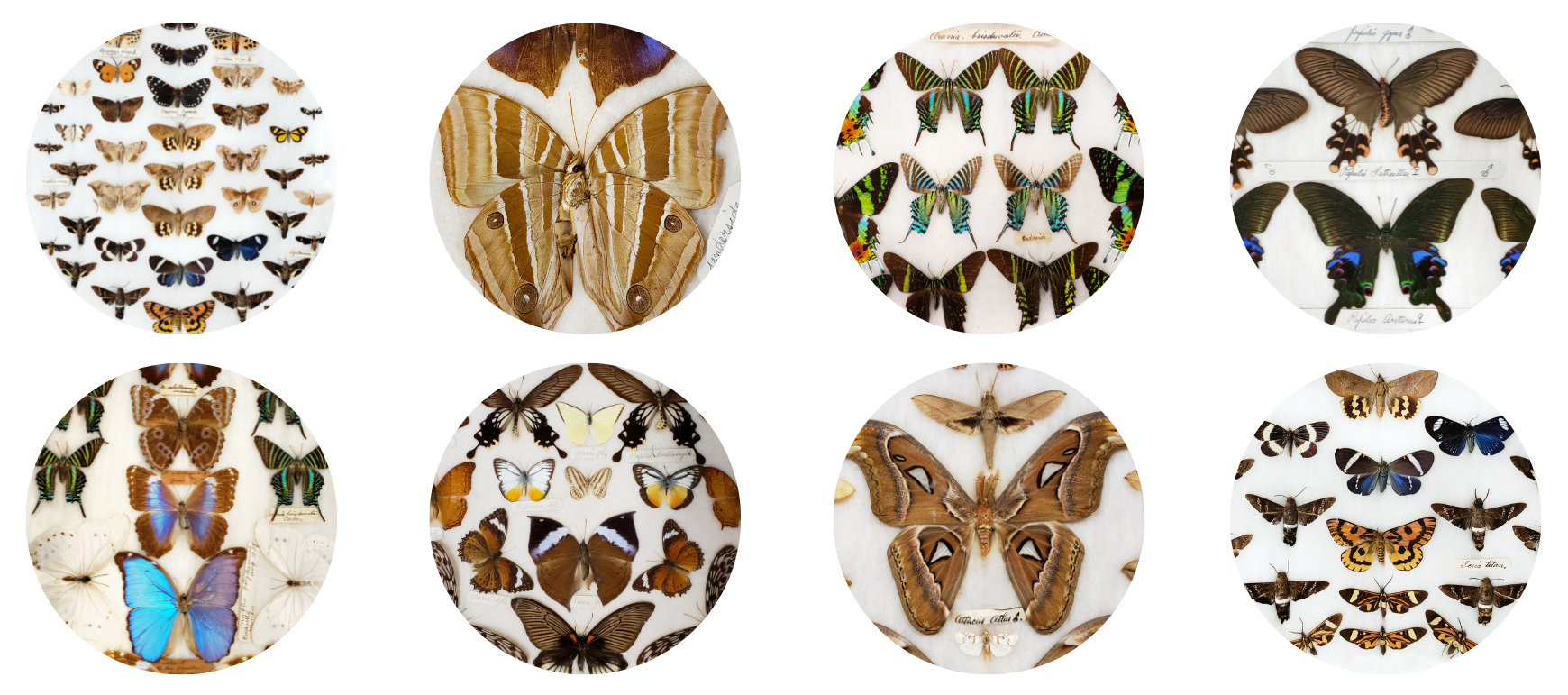
Zoological Collections, Department of Biology at Western University. Image credit: Brian Lambert.
Each of the artists in this exhibition considers insects within a multispecies ecology or cultural history. In a work from The Columbus Project, Carl Beam juxtaposes images of bees with a portrait of Christopher Columbus, addressing the historically imbricated impulses of exploration, discovery and colonization, with analysis and classification. Christi Belcourt intertwines bees, birds, strawberries, and other native plants to underscore the interconnectedness of living things within the natural world. Catherine Chalmers presents a series of extraordinary films, drawing parallels between the behaviour of neo-tropical leafcutter ant colonies and the human traits of language, ritual, war, and art, with the aim of blurring the lines between culture and nature. Originally created for Instagram, Andrea Cooper’s film Wild Honey provides a metaphorical exploration of fertility, colony collapse disorder, and climate change. Aganetha and Richard Dyck work collaboratively with bees to co-create works of art, in this instance through the use of a flatbed scanner inserted into a beehive. New work from Jude Griebel takes inspiration from Victorian anthropomorphic illustration to imagine a tiny entomological protest against the current ecological crisis. The Institute of Queer Ecology’s three-part film Metamorphosis is a call to reimagine and rebuild the planet, employing the metaphor of the life-cycle of an insect in which the organism fully restructures itself to adapt to its changing needs and ensure its survival. Jennifer Murphy combines images culled from old nature books to create composite forms that remind us of the complexity of ecological relationships. Amy Youngs “shakes hands” with a cluster of composting worms in an interspecies gesture of respect that acknowledges our dependence on the organisms that decompose our waste. Collectively, the work encourages us to consider the importance of monitoring insect biodiversity as an indicator of the health of an ecosystem, be it thriving or imperiled.
McIntosh Gallery thanks Dr. Kirsty Robertson for the original exhibition concept. Helen Gregory extends her gratitude and appreciation to her students in the Department of Visual Arts Museum and Curatorial Studies Practicum course for their input during the development of this exhibition: Avory Capes, Meghan Carnegie, Stephanie Fattori, Sarah Fletcher, Kaitlyn German, Megan Goddard, Emma Hennessey, ShaSha Hou, Kaede Kusano, Etienne Lavallee, Emma Morin, Roshieka Russell, Serena Shearly, Hanyu Xi, and Turing Xu. Nina Zitani wishes to thank her student volunteer curatorial assistants Fraser Allen, Ryan Chieu, Shukri Matan, Donald Tyler Watson M.Sc., and Natasha Weppler for their dedication and hard work helping to curate and maintain the Zoological Collections, and Staff member Mitchell Zimmer for photographing specimens. Without their input this exhibition would not have been possible.
July 4 - July 30: Ashley Snook: NODES | Animality and Kinship
NODES | Animality and Kinship
Ashley Snook
July 4 - 30, 2022
Opening Reception: Thursday, July 7, 5:00 - 7:00 p.m.
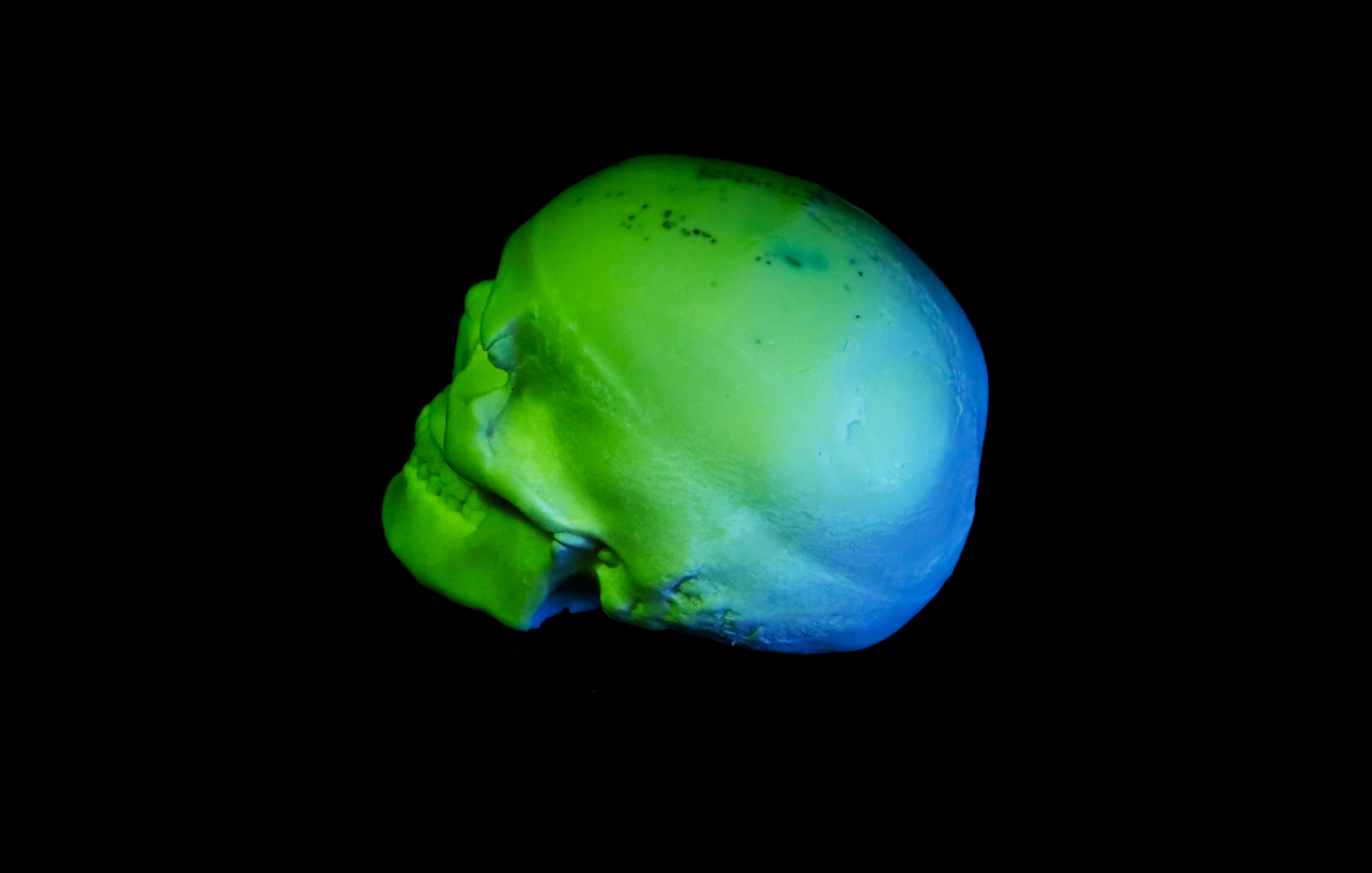 Ashley Snook, a body within a body within a body (detail), 2021-2022. Image courtesy of the artist.
Ashley Snook, a body within a body within a body (detail), 2021-2022. Image courtesy of the artist.
Welcome to the Chthulucene! A place in time that addresses living and dying together on an irreparable earth—a place in time with possibilities, including the possibility of reworlding. Here in the Chthulucene the world is a site of uncertainty and change but also a place of opportunity to look, think, and be, differently.
NODES is an exhibition that emphasizes ongoingness by addressing concepts of animality, kinship and interconnectivity with, and upon, our earth—Terra. Animality in this project is proposed as a holistic term that explores ideas and propositions for restructuring and ameliorating relationships between humans, and between humans and nonhuman species. Within Western theories of animality, nonhuman animals have regularly been considered to have the limiting capacity of being wild, part of nature and separate from, and ultimately below the human. Within this conception, the term animality has been used predominantly by white thinkers to inform what defines nonhuman animals, as well as a way to colonize and oppress peoples. The term animality has also, by contrast, been used to speak of progressive relationships between human and nonhuman species, including with respect to their connection with the environment. This exhibition probes the potential to reframe animality to refocus current perspectives with the goal of mending socio-cultural relationships and supporting environmental remediation.
Collectively, the works in this exhibition invoke transformational spaces as sites of interconnectivity as contexts in which to be present and to explore animality in both divergent and convergent ways. Through this, NODES seeks to decenter humanness, allowing space for contemplation, grief, and imagination through sensorial participation in seeing, smelling, touching, and hearing. The spirit of this exhibition, with its deployment of sculpture, drawing, video, and experiential installation, aims to provide an opportunity for us to reconnect to a sense of animality and the surrounding biosphere by promoting kinship between species, and problematizing current human-centric perspectives. It encourages that through commitment, collaborative efforts, and multispecies alliances, reworlding may become possible.
About the artist
Ashley Snook is an interdisciplinary artist residing in Tkaronto, Ontario. In her practice, Snook examines interconnectivity between human and nonhuman animals, and vegetal/botanical life. Currently, her research and studio work investigates notions of animality. More specifically, her research takes on a historically-informed perspective regarding animality to problematize a spectrum of human-centric, socio-cultural and scientific frameworks. Such frameworks are shown as the hegemonic forces that enabled rampant environmental degradation, racial injustices, and destructive human-animal relationships. The trajectory of her research aims to reconnect a raw sense of intimacy between the human and animal and the surrounding biosphere through drawing, sculpture, and installation. Snook has shown her work nationally, including in exhibitions such as Come Up To My Room at the Gladstone Hotel in 2018 as well as the recent exhibition GardenShip and State at Museum London. She has received various awards during her academic studies including, most recently, a Doctoral Fellowship from the Social Science and Humanities Research Council (SSHRC) and an Ontario Graduate Scholarship (OGS). She has also received the Joseph-Armand Bombardier Canada Graduate Scholarship (SSHRC) during her MFA at OCAD University in 2015 and 2016. Snook is currently a PhD candidate in the Art and Visual Culture program at Western University and NODES represents her culminating work within the program as her graduate thesis exhibition.
Graduate student exhibitions at McIntosh Gallery are presented in memory of King's College alumnus Gregory Franklin Child through the generous support of Western University Arts and Humanities alumni Paula Case Child and Timothy Child.
August 11 - September 10: Migration Stories Whispered in My Ear / Me Susurran Al Oído Historias de Migrantes | Michelle Paterok: At Dusk
Migration Stories Whispered in My Ear /
Me Susurran Al Oído Historias de Migrantes
Moysés Zuñiga Santiago
August 11 - September 10, 2022
Closing Reception: Friday, September 9, 5:00-7:00 p.m.
Curator: Anahí Gonzalez
Researcher: Dr. Sarah Bassnett
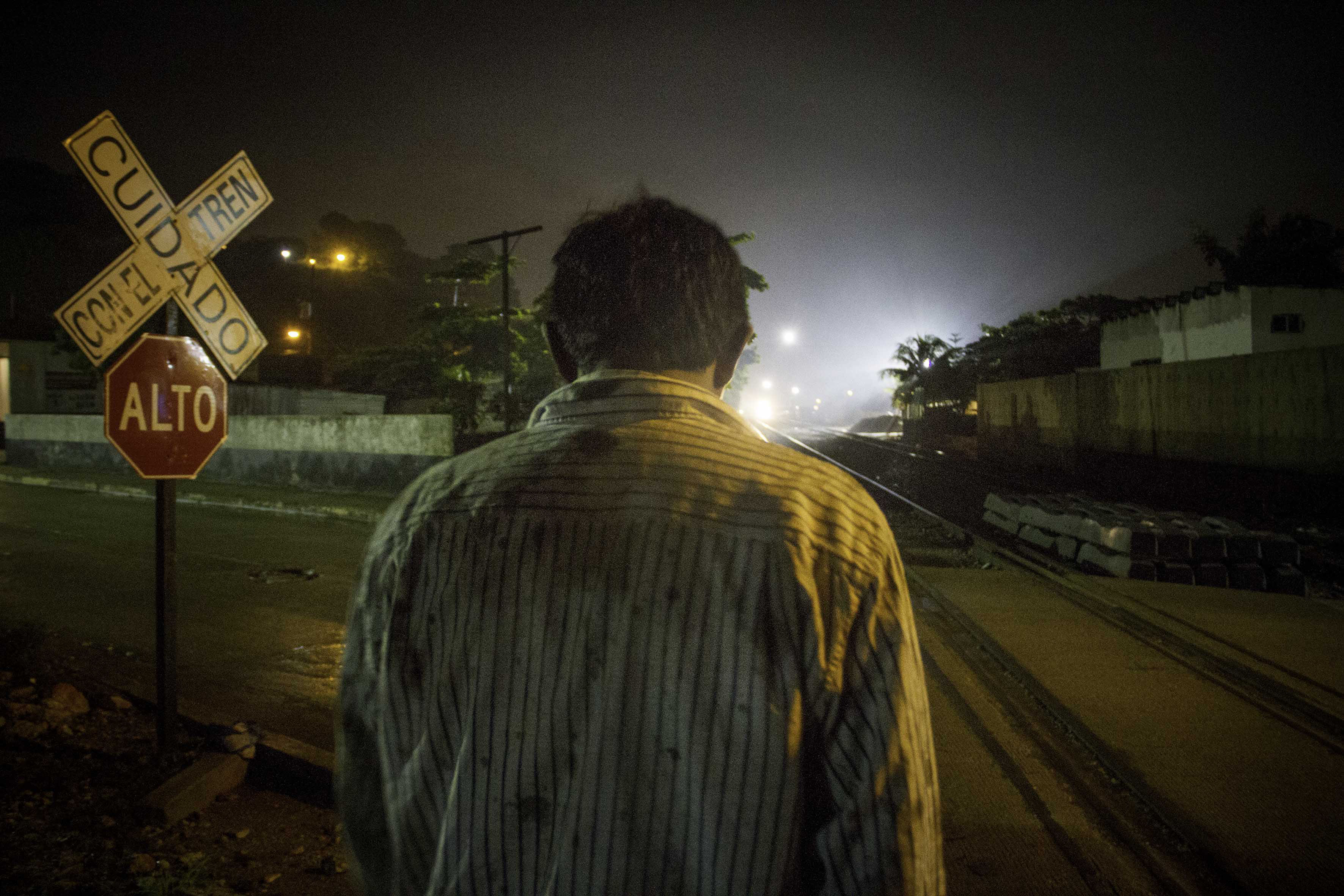
Moysés Zuñiga, Manuel, Coatzacoalcos, Veracruz, Mexico, October 29, 2012. Courtesy of the artist.
What are the social and political effects of the portrayal of migration as a crisis? How does photography impact our understanding of migration?
Criminal networks frequently target undocumented migrants crossing Mexico heading towards the United States. While human rights organizations have collected testimonies about these abuses throughout the country, the Mexican government refuses to acknowledge the connections between their immigration policies and the violence perpetrated against migrants.
Migration Stories Whispered in My Ear / Me Susurran Al Oído Historias de Migrantes presents an installation of the photographic work of Mexican photojournalist Moysés Zuñiga, who portrays the violence and injustice of undocumented migration. Zuñiga’s firsthand accounts from his travels along the migratory routes in Mexico create a visual testimony of the often-forgotten journey from the southern border between Mexico and Guatemala to Mexico’s northern border with the United States. The audio narrative by Zuñiga immerses the audience in the sounds of the mountains of San Cristobal de las Casas, Chiapas, and shares fragments of many migrants’ journeys.
The exhibition is based on SSHRC-funded research by Professor Sarah Bassnett of the Department of Visual Arts, Western University. Migration Stories Whispered in My Ear / Me Susurran Al Oído Historias de Migrantes contrasts the investigative process of one photographer with the representation of migration in the Mexican media. Collectively, the works in this exhibition address the various roles photography plays in shaping our understanding of undocumented migration in contemporary Mexico through local, national, and international lenses. The exhibition acknowledges migration routes as sites of trauma but also as contact zones where migrants can convey their experiences.
Moysés Zuñiga Santiago studied science and technology at the University of Xalapa Veracruz in 1998, where he worked in television, photography and radio. In 2003, he worked in Xalapa at Diario AZ as a photojournalist and was subsequently hired by Milenio de Veracruz as the photography editor. In January of 2006, he served as the correspondent for Mexican photography agency Cuartoscuro during Subcomandante Marcos' "Other Campaign" and travelled the entirety of Mexico with Marcos. During this time, Zúñiga also worked with the Associated Press (AP), EFE (Spain) and Agence France Press (AFP). Since 2007, Zúñiga has worked with La Jornada in San Cristóbal de las Casas and covers the Chiapas region for the Associated Press and EFE. In 2009 he received a Rory Peck Training Fund grant for freelance journalists in high-risk areas from the Rory Peck Trust. In addition, his work has been exhibited in the United States, Canada, and Mexico.
Anahí González is a Mexican photographer based in London, Ontario. She was selected to be part of the AGO X RBC Emerging Artist Exchange program (2022). She is currently an awardee of the national FONCA Young Creators Grant (Jóvenes Creadores) in Mexico with the project “Allá Más Al Norte” about Mexican labour representation in/for Canada. She holds a BA in Communication from the Universidad del Valle de México and an MFA from Western University. She is currently an Art and Visual Culture Ph.D. candidate at Western University.
Dr. Sarah Bassnett is Professor of art history at Western University. Her research focuses on the history of photography and photo-based contemporary art, especially as they relate to issues of power and resistance and moments of social change. She is the author of Picturing Toronto: Photography and the Making of a Modern City (McGill - Queen’s University Press, 2016) and co-author with Sarah Parsons of Photography in Canada, 1839-1989 (Art Canada Institute, forthcoming 2023). Her current SSHRC-funded research investigates how stories of forced migration are told through photography.
At Dusk
Michelle Paterok
August 11 - September 10, 2022
Closing Reception: Friday, September 9, 5:00-7:00 p.m.
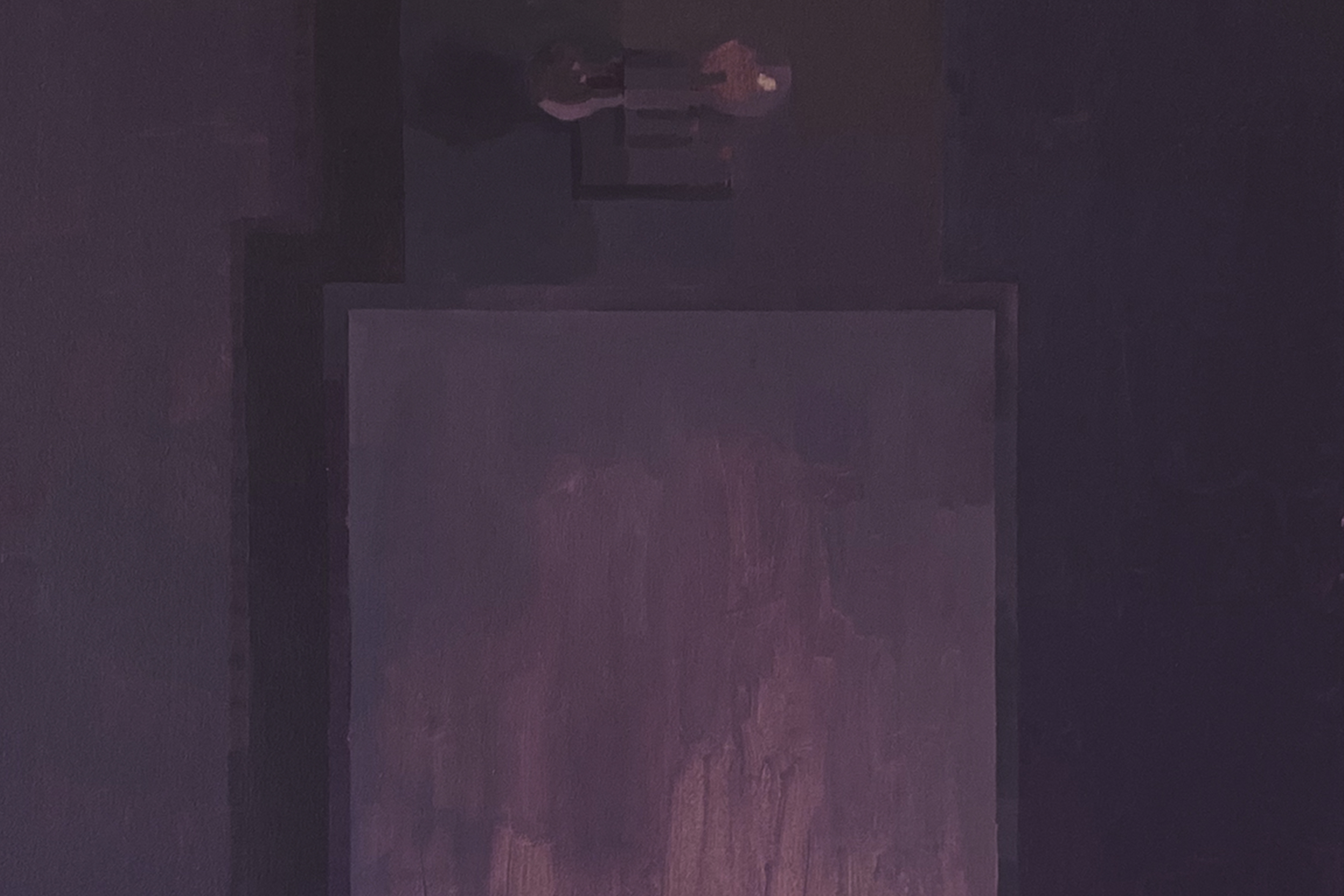
Michelle Paterok, Bathroom Mirror (detail), 2022. Oil on canvas. Courtesy of the artist.
In her painting practice, Michelle Paterok considers how spaces are experienced subjectively, how these experiences are reconstructed in our memories, and how the affordances of painting contribute to representing subjectivity. Finally, she asks what role painting might play in addressing the environmental urgencies of the present moment.
At Dusk is a series of paintings investigating the poetics of colour and light in the context of domestic space. Paterok aims to express a specific emotional atmosphere of a space, seeking to depict time unfolding in the static frame of a painting. In his 2018 book Being Ecological, Timothy Morton argues that our current historical moment is haunted by a sense of unreality: “Being in a place, being in an era, for instance an era of mass extinction,” Morton writes, “is intrinsically uncanny”. This is the lens through which the artist reinterprets her quotidian surroundings. In seeking out the poetics of the everyday, these works quietly appreciate and mourn its impermanence. In an effort to counteract both personal and collective anxiety, Paterok gestures towards finding beauty in that which is often be overlooked.
Michelle Paterok is a visual artist from Edmonton, Alberta, currently based in London, Ontario, where she is completing an MFA in Visual Arts at Western University. Paterok received a BFA in Art and Design from the University of Alberta in 2016. In 2018, she was the Canadian Artist in Residence at the Vorres Museum in Paiania, Greece. She has presented her work in solo and duo exhibitions in Canada, Greece, and Japan. Her work has been supported by the Alberta Foundation for the Arts and the Social Sciences and Humanities Research Council of Canada (SSHRC). At Dusk is her graduate thesis exhibition.
Graduate student exhibitions at McIntosh Gallery are presented in memory of King's College alumnus Gregory Franklin Child through the generous support of Western University Arts and Humanities alumni Paula Case Child and Timothy Child.
September 22 - December 10: Hunter Gatherer
Hunter Gatherer
Nicholas Crombach, Emily Jan, Philippa Jones, Meryl McMaster
September 22 – December 10, 2022
Curated by Helen Gregory
Opening Reception: Thursday, September 22 from 5:00 to 7:00 p.m.
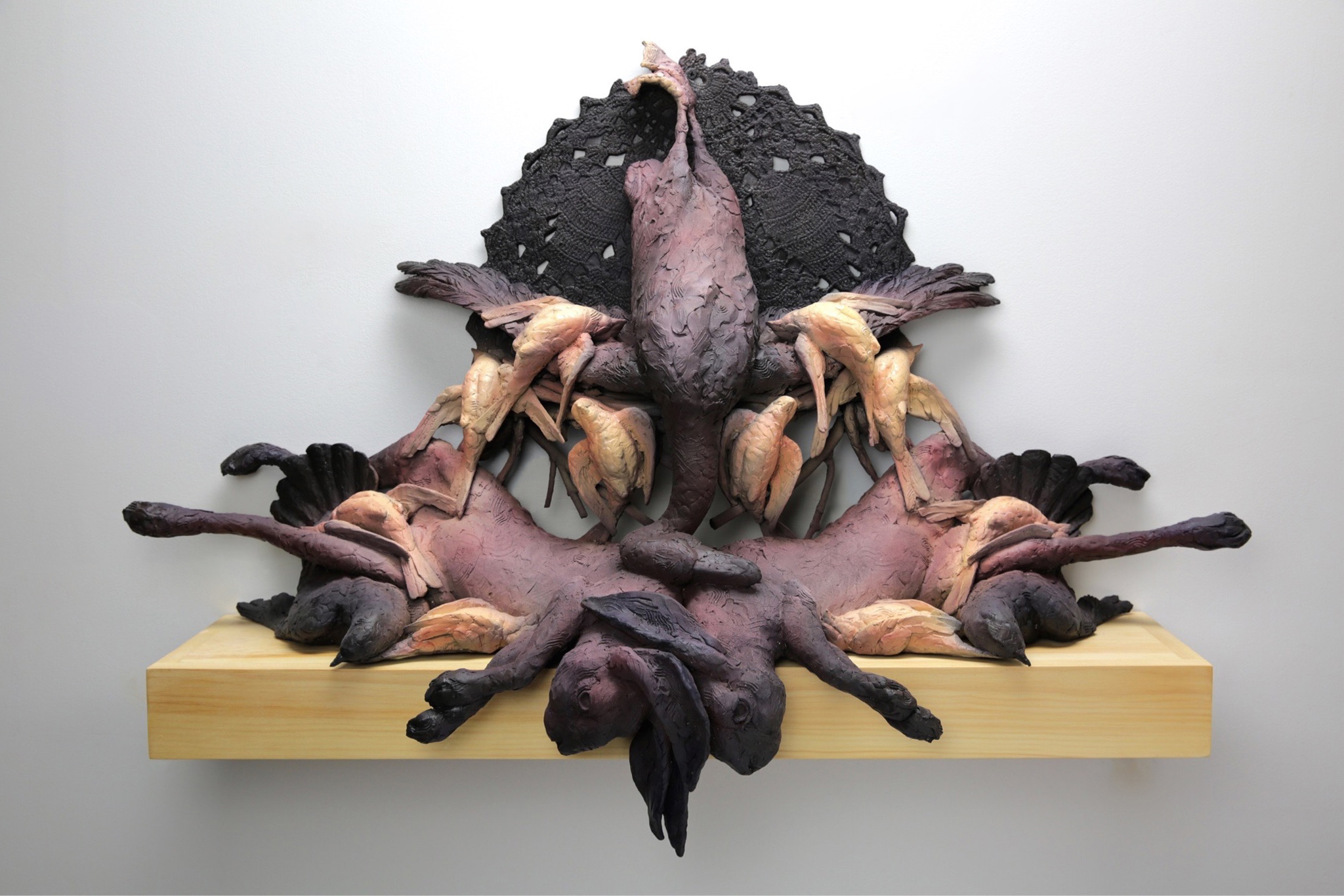 Nicholas Crombach, Nature Morte, 2016, polyurethane resin, paint. Courtesy of Art Mûr, Montreal.
Nicholas Crombach, Nature Morte, 2016, polyurethane resin, paint. Courtesy of Art Mûr, Montreal.
Hunter Gatherer is a meditation on the complex network of relationships between hunting and collecting in the context of the museum. With an emphasis on representations of the animal body, artists Nicholas Crombach, Emily Jan, Philippa Jones, and Meryl McMaster consider this dynamic from art historical and postcolonial perspectives. The exhibition creates points of intersection through references to sport hunting; acquisition, power, and dominance; decadence and excess; still life and vanitas painting; and institutional critique. Depictions of the hunted animal body are common throughout art history – particularly during the seventeenth, eighteenth, and nineteenth centuries – and are closely linked to the human desire to control nature. In addition, many of the taxidermy animals held in museum collections were acquired through hunting. This occurred during a period of intense development of natural history collections, which mirrored an era of colonial expansion. Hunting in the colonies was viewed as both sport and scientific pursuit, and many hunters justified their killing by claiming an interest in scholarly pursuits and in acquiring specimens for scientific collections. Some of these hunted animals came to form the basis of collections in natural history museums. Such collections are now subject to a rethinking and re-evaluating of their value and meaning, given that they can be perceived as metonymic to the colonial project itself. The work in this exhibition encourages us to reflect on past and present relationships with animals in an age when we are increasingly attuned to the notion of interspecies relations and kinship.Throughout his practice, Nicholas Crombach explores human-animal relationships, seamlessly combining animal imagery, art historical references, and material culture. The works in this exhibition integrate references to game paintings, hunting trophies, heraldry, and Victorian architectural ornamentation with a critique of deeply entrenched power structures. Juxtaposing images of dogs and dead animals – the hunter and the hunted – Crombach questions not only the hierarchies between humans and animals, but also the ongoing legacies that carry over from colonialism. Emily Jan’s After the Hunt (2014) reimagines Franz Snijders painting Still Life with a Roe Deer (c. 1630) in the form of a textile-based installation. The spoils of the hunt are assembled here in felt and found objects – a boar’s head and the suspended body of a roe deer is meticulously recreated, juxtaposed against decaying fruit, flowers, and various tropes associated with seventeenth century Dutch still life. Jan critiques the imagery associated with the genre of the post-hunt tableau – each luxurious object functioning as a reminder of the excesses, exploitation, and violence of colonialism, as well as a reminder us of the transience of existence. Philippa Jones presents three monumental drawings of moose necropsies, disrupting the notion of the grotesque by revealing the beauty previously hidden below the surface of the skin. These drawings are exquisite depictions of the aftermath of a moose hunt in Newfoundland, an event that reminds us of the interrelationship of death, consumption, and sustenance. Created in an attempt to come to terms with the death of a close friend, one of the drawings also subtly references Caravaggio’s Incredulity of Saint Thomas (1601-1602), fingers delicately probing flesh, seeking explanations and solace in the bodies of the dead. Meryl McMaster has created three multimedia works in response to the nineteenth century bell jars containing taxidermied birds, held in the collection of the McCord Museum in Montreal. Combining photography, video, and sculpture, McMaster questions the desire to capture and preserve animal specimens in an attempt to freeze their bodies in time. Furthermore, she draws parallels between this mode of representing animal specimens to the way in which Indigenous peoples have been portrayed in ethnographic museums wherein Indigenous people and nature were both viewed as something to be tamed and domesticated.
Helen Gregory extends her gratitude to research assistant Megan Godard for her help with this project.
About the artists
Nicholas Crombach (BFA, 2012) currently works in Kingston, Ontario. He has been awarded the Elizabeth Greenshields Foundation Award and is the recipient of grants from the Toronto Arts Council, The Ontario Arts Council, and Canada Council for the Arts.
In 2017 Crombach presented a solo exhibition, Behind Elegantly Carved Wooden Doors, at Art Mûr Montreal receiving reviews in Border Crossings Magazine (summer 2018) and Vie des Arts (Winter 2017-18). His solo exhibition, The End of the Chase, travelled in 2018-2019, exhibiting at New Art Projects in London UK, Art Mûr Berlin and Art Mûr Montréal. In 2019 Crombach produced an exhibition of collaborative works with artist Nurielle Stern entitled Whale Fall, presented at The Canadian Clay and Glass Gallery in Waterloo. He has been awarded several major commissions for public sculpture, including Billy, Nanny, and the Kids, in Burlington, ON, and Horse and Cart located in Victoria Park, Kingston, ON. He is currently working on Flock, for Niagara Falls Exchange in Niagara Falls, ON, and Wind Vane for Florence Carlyle Park in Woodstock, ON.
In 2016-2017 Crombach participated in a year-long residency at The Florence Trust (London, UK), and recently was artist in residence at The Studios at MASS MoCA (summer 2022) in North Adams, Massachusetts.
Emily Jan is a Chinese-American artist and writer currently based in Edmonton, AB. Her biophilic sculptures and installations combine the found with the fabricated to evoke the faraway and the fantastical. As a wanderer, naturalist, and collector of objects and stories, she is guided in her work by the spirit of exploration, kinship, and curiosity.
Jan has recently exhibited at the 10e Biennale national de sculpture contemporaine, (Trois Rivières, QC), Textile Museum of Canada (Toronto, ON), the Robert Bateman Centre Gallery of Nature (Victoria, BC) Galerie Art Mûr (Montreal, QC), the Museo Textil de Oaxaca (Mexico), and the Mary M. Torggler Fine Arts Centre (Newport News, VA). Upcoming exhibitions are scheduled for the Art Gallery of Southwestern Manitoba, the McIntosh Gallery at Western University (London, ON), and dC3 Gallery (Edmonton, AB). She has participated in residencies at Artscape Gibraltar Point (Toronto Island, 2018), the Elsewhere Museum (Greensboro NC, 2017), and Denali National Park (Alaska, 2016). Jan has written and illustrated three books: still life (2014), A Denali Book of Hours (2017) and Glory of the Seas: A Shell Collector’s Journey (2019, with Stephen H. Kawai), and contributed writing to catalogues for the PHI Foundation (formerly DHC/ART), the Studio Art Quilt Associates (SAQA), and magazines such as esse: art + opinions. She currently teaches at MacEwan University, and sits on the board of directors for Union House Arts Inc, Newfoundland, and CARFAC Alberta.
Philippa Jones has been living and practicing in St. John’s, Newfoundland since immigrating from the United Kingdom over a decade ago. She is a mother, visual artist and Executive Director of Eastern Edge Gallery. Central to Jones’ work is the exploration of constructed realities, our relationship to mortality and time, active myth making, wonder and the inquisitive mind. Jones completed a BFA and an MFA at Falmouth University (UK).
Jones’ diverse art practice includes sculpture, drawing, painting, stop motion animation, art games and interactive installations. She has exhibited at major public galleries, including The National Gallery of Canada, The Rooms Provincial Art Gallery (NL), Beaverbrook Art Gallery (NB), Two Rivers Gallery (BC) and the Confederation Centre (PEI). In 2012 Jones was the recipient of the VANL-CARFAC Excellence in Visual Arts Emerging Artist award and in 2019 won the Milestone Award. Jones was longlisted for the Sobey Art Award in 2019, and in 2020 was shortlisted for ArtsNL Artist of the Year.
Meryl McMaster is a Canadian artist with nêhiyaw (Plains Cree), British and Dutch ancestry. She earned her BFA in Photography from the Ontario College of Art and Design University (2010) and is currently based in Québec, Canada. Known for her large-format self-portraits that have a distinct performative quality, she explores questions of self through land, lineage, history, and culture, with specific reference to her mixed nêhiyaw (Plains Cree), British and Dutch ancestry.
McMaster’s work has been the subject of solo exhibitions at Urban Shaman, Winnipeg (2021), McCord Museum, Montréal (2021), Canada House, London (2020), Ikon Gallery, Birmingham (2019), Ryerson Image Centre, Toronto (2019), Glenbow, Calgary (2019), The Rooms, St. John's (2018) Momenta Biennale, Montréal (2017), Museum of Contemporary Native Arts, Santa Fe (2015), and Smithsonian National Museum of the American Indian, New York (2015), amongst others.
From 2016-2020 her solo exhibition Confluence travelled to nine cities in Canada, including stops at the Richmond Art Gallery (2017), Thunder Bay Art Gallery (2017), University of Lethbridge Art Gallery (2018), and The Judith and Norman Alix Art Gallery, Sarnia (2020).
Her work has appeared in group exhibitions at Sprengel Museum, Hannover (2021), Carleton University Art Gallery, Ottawa (2020), Australian Centre for Photography, Australia (2019), National Gallery of Canada, Ottawa (2018), Ottawa Art Gallery (2018, 2019), Kitchener Waterloo Art Gallery (2016, 2019), the Musée national des beaux-arts du Québec (2019), Plug In Institute for Contemporary Art, Winnipeg (2017), and Art Gallery of Guelph (2017), amongst others.
She was shortlisted for the Rencontres d’Arles New Discovery Award 2019, longlisted for the 2016 Sobey Art Award, and is the recipient of numerous awards including the Scotiabank New Generation Photography Award, REVEAL Indigenous Art Award, Charles Pachter Prize for Emerging Artists, Canon Canada Prize, Eiteljorg Contemporary Art Fellowship and OCAD U Medal.
Her work has been collected by significant Canadian institutions, including the Art Gallery of Ontario, Montréal Museum of Fine Art, and the National Gallery of Canada.
McMaster is represented by Stephen Bulger Gallery (Toronto, ON) and Pierre-François Ouellette art contemporain (Montréal, QC).
Related Programming
McIntosh Gallery & Art Now! Presents: Hunter Gatherer Panel Discussion
Thursday, November 17 at 7PM
Watch a recording of the virtual panel discussion featuring exhibiting artists Nicholas Crombach, Emily Jan, Philippa Jones and Meryl McMaster, presented in partnership with the Department of Visual Arts' Art Now! Speakers' Series. Moderated by exhibition curator Dr. Helen Gregory, panelists discussed their work in relation to the issues addressed in this exhibition as well as within the context of their broader studio practices.
Watch online here.
Contemporary art, visual culture, and art history have long played an important role in facilitating constructive social, political, and diverse cultural conversations.
As such, McIntosh Gallery stands by its responsibility to support the artistic freedom of all exhibiting artists by providing a safe and respectful space for them to express themselves and showcase their work and research. The works in these exhibition express the views of their creators and do not reflect the position of McIntosh Gallery or Western University.


